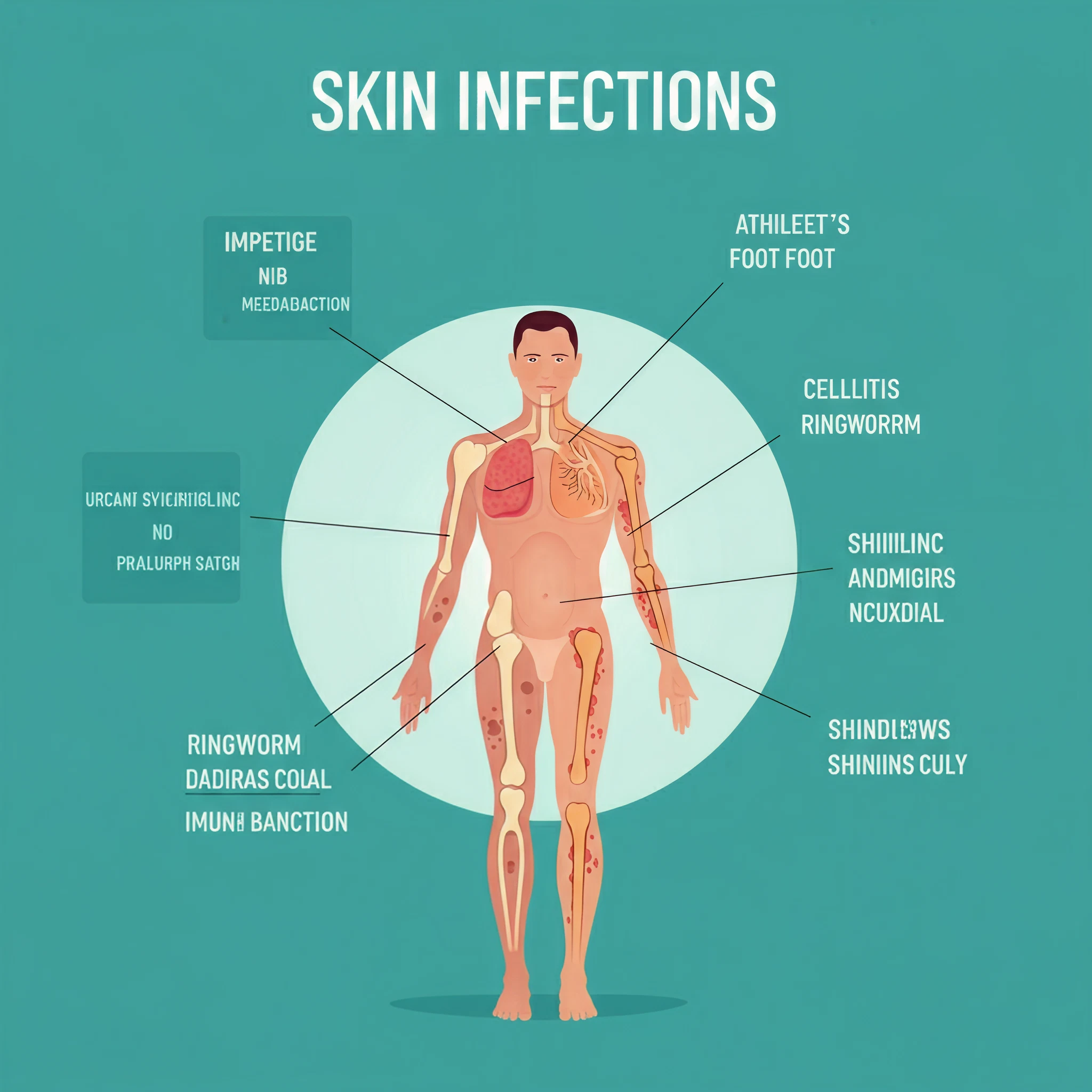Skin infections are among the most common health issues, affecting millions of people worldwide. Caused by various microorganisms, skin infections can range from mild annoyances to serious medical conditions that require immediate care. Understanding the five main types of skin infections is essential for tackling their symptoms, causes, and treatments effectively.
This article addresses the keyword “What Are the 5 Types of Skin Infections” and provides an easy-to-understand guide for health enthusiasts, skincare beginners, and anyone curious about this important topic.
What Are Skin Infections?
A skin infection occurs when germs or pathogens such as bacteria, viruses, fungi, or parasites invade the skin or the soft tissues beneath it. Depending on the type and severity, these infections can cause a wide range of symptoms, like redness, swelling, pain, itching, or sores. Immediate diagnosis and treatment are often critical to prevent complications.
Now, let’s explore the five types of skin infections in more detail.
1. Bacterial Skin Infections
Bacterial skin infections are caused by harmful bacteria that invade the skin. These infections are among the most common and can range from mild conditions to severe infections that require medical attention.
Examples of Bacterial Skin Infections:
- Cellulitis: A common infection causing redness, swelling, and pain.
- Impetigo: Often affecting children, this infection causes red, itchy sores that can develop honey-colored scabs.
- Boils and Carbuncles: Pus-filled lumps that form when bacteria infect hair follicles.
- MRSA (Methicillin-resistant Staphylococcus aureus): A type of staph infection that’s resistant to antibiotics and requires specialized treatment.
Symptoms:
- Redness and swelling
- Warmth and tenderness
- Painful, pus-filled bumps
Treatment:
Topical or oral antibiotics are commonly prescribed based on the severity of the condition.
2. Viral Skin Infections
Viral skin infections arise when viruses attack your skin cells. These infections can be either acute or chronic and often appear as sores or rashes.
Examples of Viral Skin Infections:
- Warts: Caused by the human papillomavirus (HPV), they commonly affect the hands and feet.
- Shingles (Herpes Zoster): A painful, blistering rash caused by the reactivation of the chickenpox virus.
- Herpes Simplex Virus (HSV): These painful blisters often appear around the mouth or genitals.
Symptoms:
- Blisters or sores
- Pain or itching
- Tingling or burning sensations
Treatment:
Antiviral medications like acyclovir or valacyclovir are prescribed to manage symptoms and reduce the duration of the infection.
3. Fungal Skin Infections
Fungi thrive in warm, moist environments, making fungal infections particularly common in areas like the feet, groin, and armpits. While these infections are rarely serious, they can be irritating and may spread if left untreated.
Examples of Fungal Skin Infections:
- Athlete’s Foot (Tinea Pedis): Causes itchy, scaly skin on the feet.
- Ringworm (Tinea Corporis): A common infection characterized by circular, red rashes.
- Yeast Infection (Cutaneous Candidiasis): Often occurs under skin folds or in moist areas.
Symptoms:
- Scaly or flaky skin
- Redness and itchiness
- Cracks or sores in the infected area
Treatment:
Antifungal creams, powders, or oral medications help to eliminate fungal infections.
4. Parasitic Skin Infections
Parasitic skin infections are caused by tiny organisms that live on or in your skin. These infections are often associated with poor hygiene or close physical contact with infected individuals.
Examples of Parasitic Skin Infections:
- Scabies: Tiny mites burrow into the skin, causing extreme itching.
- Lice (Pediculosis): Common in the scalp but can also affect the body or pubic area.
- Hookworm: Often transmitted through contaminated soil, causing itchy rashes.
Symptoms:
- Intense itching
- Red bumps or blisters
- Visible signs of parasites, like lice or nits in hair
Treatment:
Medications like permethrin or ivermectin are effective for treating parasitic infections.
5. Fungal Skin Infection (Additional Note)
Fungal infections are differentiated based on their presentation or area of influence – another necessary clarification to understand their recurring similar integrations.
Prevention Tips for Skin Infections
While the symptoms and treatment of skin infections vary, preventing them often involves maintaining basic hygiene and practicing caution during social or outdoor activities. Here are some tips to help you minimize the risk of skin infections:
- Wash your hands regularly with soap and water.
- Keep wounds clean and covered with bandages until fully healed.
- Avoid sharing personal items like towels, razors, or clothing.
- Use shower shoes in locker room areas.
- Change out of sweaty clothes immediately after exercise.
- Keep your skin moisturized to avoid cracks and irritation.
By following these preventive measures, you can significantly reduce your chances of developing a skin infection.
Call to Action
Understanding and treating skin infections promptly is essential to maintaining your overall health. If you’re interested in more in-depth information or need help managing a skin concern, consult with a dermatologist or trusted healthcare provider.
Got questions about skincare or infections? Share your thoughts in the comments below or explore our other health guides for more expert advice!








